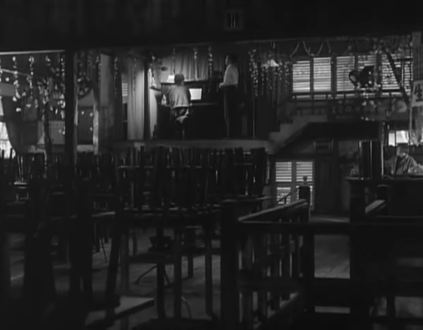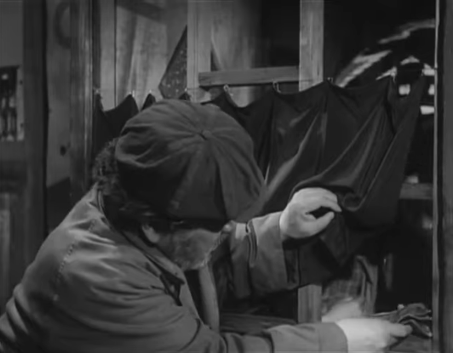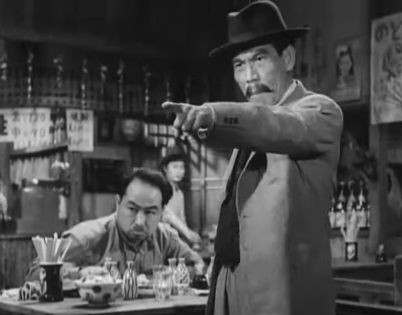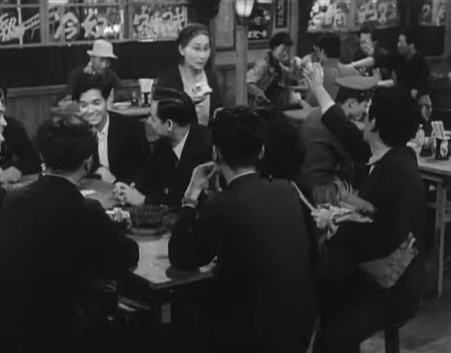Physical Address
304 North Cardinal St.
Dorchester Center, MA 02124

(Continued from Page 1)
This is arguably Uchida’s most lovable film. I call Twilight Saloon “the first Robert Altman movie,” because the picture does what almost all the best Altman movies (for example, Nashville, 1975) attempt to do: depict a self-contained community and its complex relationships by shifting the narrative focus from character to character, with no one figure retaining the dramatic center for long. (At the time Uchida’s film was released, Altman was still churning out industrial films in the Midwest.)1
Apparently, however, this approach to narrative was too much for the Japanese critics of the day. Of the three movies Uchida released in 1955, this was the only one that didn’t appear at all in the Kinema Junpo (KJ) poll of the thirty most critically-acclaimed films of that year. (A Bloody Spear at Mount Fuji ranked in KJ’s Best Ten at number eight, while A Hole of My Own Making appeared at the very bottom of the poll, tying for 30th place.) Twilight Saloon’s status as a classic has thus been acknowledged only quite recently.

This work is one of Uchida’s most virtuosic movies, an experiment with the possibilities of cinematic movement within a single set, such as Hitchcock was doing contemporaneously with films like Rope (1948) and Rear Window (1954). Just when you think Uchida has exhausted the possibilities of the space, he finds an interesting new angle through which to frame his characters, or handles the camera in a totally unexpected manner.
It’s been claimed that the director, a great fan of Hollywood cinema, was inspired here by Edmund Goulding’s famous 1932 film, Grand Hotel, which depicts numerous characters from many classes interacting at a single location within a narrow time frame. (Uchida’s previous movie, A Bloody Spear on Mount Fuji, though a jidai-geki film, has been said to draw upon this same source.) But in thematic and dramatic complexity, and definitely in visual flair, Uchida far surpasses his American model.
When we think of choreography in musical films, we naturally think of dancing. But there’s only one very modest dance sequence in the picture: Emy Rosa’s striptease (of sorts) to a theme by Tchaikovsky. The real “choreography” here is the amazingly precise, yet completely realistic movement of the characters within this very large set. The rehearsing of the performers – particularly the barmaids, who seem to be everywhere at once – must have been incredibly complex, rigorous and difficult, but the effect achieved by this intricate interweaving of characters is wonderful.
There’s also a wondrous sense of mystery in the film: things happen which are immensely suggestive but, because the viewer lacks the context for them, their significance is elusive. At one point, a young man the viewer hasn’t seen before suddenly runs, in the crowded bar, from the background to the foreground of the scene and, desperate to elude someone, leaps over the railing surrounding the stairwell and jumps down into the street below. A few seconds later, an angry-looking middle-aged man in a business suit runs into the frame and rushes (nearly knocking down Tetsuo in his haste) down the stairs in pursuit of the younger man. Is this simply a pickpocket trying to evade his furious victim, or is some more nefarious relationship between the two men implied? We never find out – and that’s the beauty of such seemingly irrelevant details.
It should also be noted that there are no extras in the film, or almost none. Even most of the characters in the background who have no dialogue are acting their roles, not just adding atmosphere. (I am a former extra myself, so I’m keenly sensitive to a director’s use of background performers.) This great gift – the ability to direct the performance of an entire crowd, which is almost completely unknown to today’s filmmakers – was also exhibited by Kurosawa and Mizoguchi (to name two) in their Golden Age films.

The painter Umeda, the closest thing to a protagonist this film offers, and one of the most attractive and compelling characters in Uchida’s movies, is a fascinating figure. Guilt-ridden because he had allowed his artistic talent to be exploited via the creation of wartime propaganda, he seeks to atone with small acts of personal kindness, like passing out little gifts of cigarettes or liquor. He even aids the troubled young barmaid, Yuki, by convincing her employer to offer her a desperately needed advance. There’s a lovely bit in this scene in which Umeda, having obtained the cash from the bar manager, slips it to Yuki under a curtain, semi-surreptitiously, as if refusing to acknowledge that it’s really from him.
The only artwork we see Umeda create is a portrait on a poster of his friend Yamaguchi, and that only as a means to get money from him to pay back the bar manager for his loan to Yuki. We sense that Umeda is not a mediocrity or a has-been; he probably has real talent. But he has deliberately frittered it away, as a perhaps perverse self-punishment for a youthful thirst for fame that had fatally tempted him to support a war he never believed in.
Umeda’s career has obvious correspondences to that of Uchida himself. The director had been a staunch left-winger in the 1930s, but had betrayed his beliefs to go to Manchuria to work at Manei studios for the Fascist child murderer Amakasu Masahiko. (There’s much evidence that Uchida was tormented by guilt for the rest of his life by this decision.) But Kosugi Isamu – here giving his farewell performance for Uchida – also has much in common with the morally compromised artist he portrays.
In perhaps his most famous role, Kosugi had played the male lead in the infamous 1937 German-Japanese co-production, The New Earth (Atarashiki Tsuchi), directed, in two very different versions (I’ve seen both), by the Nazi Dr. Arnold Fanck and the great jidai-geki director Itami Mansaku. This movie was released in Europe, including Germany, where it was titled The Daughter of the Samurai (Die Tochter des Samurai).
In that film, the hero bafflingly rejects his fiancée, played by the lovely young Hara Setsuko, and falls for a cold, blonde Aryan woman who, in the gentlest possible way, at last convinces him that his infatuation with her is racially inappropriate. The film made the teenage Hara a huge star in Japan, and this has somewhat overshadowed its significance as a dubious relic of the German-Japan alliance – and a harbinger of much Fascist propaganda to come. Thus, both star and director had serious sins for which to atone.

Much has been made by critics of the satirical characters Onizuka and Kibe, war veterans reduced to very modest circumstances as civilians in peacetime. Uchida may have had in mind the widespread fear of a possible resurgence of the militarist right, but if so, he doesn’t appear to take that possibility very seriously. The director understands that these two men, who can barely pay for their bar tab, and those who think like them, are not going to foment a right-wing coup any time soon.

On the other hand, Uchida doesn’t have much respect for the left-wingers, either. There’s a very brief but telling scene in which an obviously destitute woman wanders from table to table in the bar, trying to make a meager income selling cigarettes, but a table full of “existentialist” students – hard-drinking champions of the working class – rudely brush off this poor old lady, obviously not mistaking her for one of the downtrodden ones whose cause they claim to espouse. It may well have been his exposure to real, hard-core revolutionaries in China that prompted Uchida to depict these tavern radicals less than reverently.
(Continued on Page 3)
[…] Twilight Saloon (Tasogare Sakaba; たそがれ酒場), 1955 […]
[…] the Japanese musical at New York’s Japan Society, another Uchida movie filmed a decade earlier, Twilight Saloon (Tasogare sakaba, 1955). This film painted a satirical yet sympathetic portrait of the denizens of […]
[…] continuing his acting career. His final performance for Uchida was as the bohemian artist Umeda in Twilight Saloon […]
[…] (Keisatsukan, 警察官), 1933A Bloody Spear at Mount Fuji (Chiyari Fuji; 血槍富士), 1955Twilight Saloon (Tasogare Sakaba; たそがれ酒場), 1955Chikamatsu’s Love in Osaka (Naniwa no koi no monogatari; 浪花の恋の物語), […]